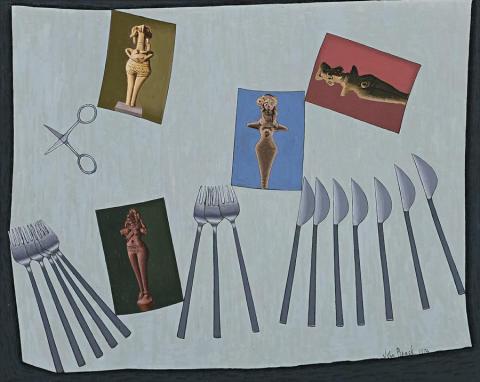THE FERTILITY GODDESSES, 1974
JOHN BRACK
oil on canvas
61.0 x 76.5 cm
signed and dated lower right: John Brack 1974
Rudy Komon Gallery, Sydney
Private collection, Sydney
John Brack: Recent Paintings, Joseph Brown Gallery, Melbourne, 24 February – 11 March 1975 (illus. in exhibition catalogue)
John Brack, Rudy Komon Gallery, Sydney, 13–31 December 1975, cat. 13 (label attached verso)
Grishin, S., The Art of John Brack, Oxford University Press, Melbourne, 1990, vol. I, p. 132, vol. II, cat. o225, pp. 30 and 157 (illus.)
'...in the grand gallery of the Louvre... a thousand masterpieces all with signatures and all saying 'Look at me, I'm a genius... I could not bear it. The noise was intolerable, I could not stay there. I had to go downstairs and look at the Egyptians...'1
When, in late 1973, the Bracks left Australia for the first time to visit the great historical cities and hallowed museums of England and Europe, the experience was not to be as the artist had expected. Although the opportunity to view masterpieces previously only known through reproduction left Helen buoyant, John was instead disconcerted by the dreaded loss of control which he suddenly felt in such unfamiliar surroundings. Moreover, gallery expeditions inevitably left him disappointed - the clashing personality cults of the old and modern masters troublesome and 'noisy' by comparison to the restraint and anonymity of the ancients (particularly those cultures not belonging to the classical or Graeco-Roman tradition upon which so much of European art was predicated). Thus, perhaps not surprisingly, upon his return Brack became preoccupied with the challenge of restoring the peace and silence of ancient art to contemporary painting. The solution however, was not immediate and indeed, it would be eighteen months before the influence of his sojourn abroad appeared in his work.
Belonging to the 'Unstill Life Series' (as Brack ironically dubbed the inaugural exhibition at Joseph Brown Galleries in 1975), The Fertility Goddesses 1974 is a superb example of such compositions in which the knife, fork and scissor motifs of his earlier shop window paintings now precariously intermingle with glamorised postcards featuring fragments of prehistoric art. With the attitudes expressed towards the postcards by this society of utensils ranging from admiration to disregard and angry assault, accordingly the series may be interpreted as a comment upon the perception of ancient cultures by the modern world. There is also truth to Grishin's argument that Brack's postcard imagery emerged from the artist's fascination with the souvenirs' 'user-friendly' aspect which made them less intimidating (and paradoxically, more appealing) to viewers than the artworks themselves - an accessibility accentuated by the postcards' ability to present 'improved' versions of the original.2 In this vein, the series resonates with the artist's appreciation of both the writings of French art theorist Andre Malraux (especially his concept of the portable, personal musee imaginaire) and the art of surrealist Rene Magritte who often included paintings of paintings within his canvases to highlight prevailing notions of the artificial being more real than the real thing.3 As Grishin aptly encapsulates, the series 'raises questions of the authenticity, falsification and durability of art as well as permanence, stability and impersonality in a glittering but collapsing society.'4
Perhaps surprisingly given the richness of meaning acknowledged today, when these early postcard paintings were first unveiled in Melbourne in 1975, they remained largely elusive to most viewers. Not only did the series herald a new style of painting which notably effaced Brack's presence as artist, the meticulously smooth, unified surfaces carefully constructed from subtle glazes deliberately eliminating any trace of the 'individual' or 'romantic' gestural hand. But perhaps most bewilderingly for the public and art-informed alike was the complete disappearance of the human figure and apparent lack of social commentary. Recalling the dilemma years later, thus Helen elaborates 'Reaction to these works was one of shock... People were embarrassed by these pictures that were obviously done so well, but what was the point of them?'5
1. John Brack on John Brack, 1977, p. 8 cited in Grishin, S., The Art of John Brack, vol I, Oxford University Press, Melbourne, 1990, p. 128
2. Grishin, ibid., p. 131
3. Gott, T., A Question of Balance: John Brack 1974-1994, Heide Museum of Modern Art, Melbourne, 2000, p. 7
4. Grishin, op.cit., p. 133
5. Helen Maudsley, interview, 18 January 2000 cited in Gott, ibid., p. 8
VERONICA ANGELATOS
